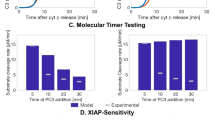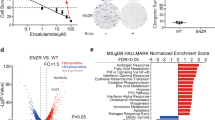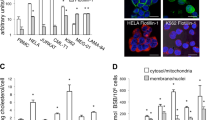Abstract
The contribution of different proteolytic systems, in particular calpains and effector caspases, in apoptotic cell death is still controversial. In this paper, we show that during cisplatin-induced apoptosis of human metastatic melanoma cells, calpain activation, as measured in intact cells by two different fluorescent substrates, is an early event, taking place well before caspase-3/-7 activation, and progressively increasing during 48 h of treatment. Such activation appears to be independent from any intracellular calcium imbalance; in fact, an increase of cytosolic calcium along with emptying of the reticular stores occur only at very late stages, uniquely in frankly apoptotic, detached cells. Calpain activation proves to be an early and crucial event in the apoptotic machinery, as demonstrated by the significant protection of cell death in samples co-treated with the calpain inhibitors, MDL 28170, calpeptin and PD 150606, where a variable but significant reduction of both caspase-3/-7 activity and cell detachment is observed. Consistently, such a protective effect can be at least partially due to the impairment of cisplatin-induced p53 activation, occurring early in committed, preapoptotic cells. Furthermore, in late apoptotic cells, calpain activity is also responsible for the formation of a novel p53 proteolytic fragment (≈26 kDa), whose function is so far to be elucidated.
This is a preview of subscription content, access via your institution
Access options
Subscribe to this journal
Receive 50 print issues and online access
$259.00 per year
only $5.18 per issue
Buy this article
- Purchase on Springer Link
- Instant access to full article PDF
Prices may be subject to local taxes which are calculated during checkout







Similar content being viewed by others
References
Arora AS, deGroen PC, Croall DE, Emori Y, Gores GJ . (1996). Hepatocellular carcinoma cells resist necrosis during anoxia by preventing phospholipase-mediated calpain activation. J Cell Physiol 167: 434–442.
Atencio IA, Ramachandra M, Shabram P, Demers GW . (2000). Calpain inhibitor 1 activates p53-dependent apoptosis in tumor cell lines. Cell Growth Differ 11: 247–253.
Biswas S, Chida AS, Rahman I . (2006). Redox modifications of protein-thiols: emerging roles in cell signaling. Biochem Pharmacol 71: 551–564.
Chen L, Marechal V, Moreau J, Levine AJ, Chen J . (1997). Proteolytic cleavage of the mdm2 oncoprotein during apoptosis. J Biol Chem 272: 22966–22973.
Daniel KG, Anderson JS, Zhong Q, Kazi A, Gupta P, Dou QP . (2003). Association of mitochondrial calpain activation with increased expression and autolysis of calpain small subunit in an early stage of apoptosis. Int J Mol Med 12: 247–252.
Davies EV, Hallet MB . (1998). High micromolar Ca2+ beneath the plasma membrane in stimulated neutrophils. Biochem Biophys Res Commun 248: 679–683.
Del Bello B, Valentini MA, Mangiavacchi P, Comporti M, Maellaro E . (2004). Role of caspases-3 and -7 in Apaf-1 proteolytic cleavage and degradation events during cisplatin-induced apoptosis in melanoma cells. Exp Cell Res 293: 302–310.
Del Bello B, Valentini MA, Zunino F, Comporti M, Maellaro E . (2001). Cleavage of Bcl-2 in oxidant- and cisplatin-induced apoptosis of human melanoma cells. Oncogene 20: 4591–4595.
Gamberucci A, Innocenti B, Fulceri R, Banhegyi G, Giunti R, Pozzan T et al. (1994). Modulation of Ca2+ influx dependent on store depletion by intracellular adenine-guanine nucleotide levels. J Biol Chem 269: 23597–23602.
Gao G, Dou QP . (2000). N-terminal cleavage of bax by calpain generates a potent proapoptotic 18-kDa fragment that promotes bcl-2-independent cytochrome C release and apoptotic cell death. J Cell Biochem 80: 53–72.
Gentiletti F, Mancini F, D'Angelo M, Sacchi A, Pontecorvi A, Jochemsen AG et al. (2002). MDMX stability is regulated by p53-induced caspase cleavage in NIH3T3 mouse fibroblasts. Oncogene 21: 867–877.
Ghibelli L, Coppola S, Rotilio G, Lafavia E, Maresca V, Ciriolo MR . (1995). Non-oxidative loss of glutathione in apoptosis via GSH extrusion. Biochem Biophys Res Commun 216: 313–320.
Ghibelli L, Fanelli C, Rotilio G, Lafavia E, Coppola S, Colussi C et al. (1998). Rescue of cells from apoptosis by inhibition of active GSH extrusion. FASEB J 12: 479–486.
Glading A, Bodnar RJ, Reynolds IJ, Shiraha H, Satish L, Potter DA et al. (2004). Epidermal growth factor activates m-calpain (calpain II), at least in part, by extracellular signal-regulated kinase-mediated phosphorylation. Mol Cell Biol 24: 2499–2512.
Goll DE, Thompson VF, Li H, Wei W, Cong J . (2002). The calpain system. Physiol Rev 83: 731–801.
Gonen H, Shkedy D, Barnoy S, Kosower NS, Ciechanover A . (1997). On the involvement of calpains in the degradation of the tumor suppressor protein p53. FEBS Lett 406: 17–22.
Gorka M, Godlewski MM, Gajkowska B, Wojewodzka U, Motyl T . (2004). Kinetics of Smac/DIABLO release from mitochondria during apoptosis of MCF-7 breast cancer cells. Cell Biol Int 28: 741–754.
Gottlieb TM, Oren M . (1996). p53 in growth control and neoplasia. Biochim Biophys Acta 1287: 77–102.
Han Y, Weinman S, Boldogh I, Walker RK, Brasier AR . (1999). Tumor necrosis factor-alpha-inducible IkappaB alpha proteolysis mediated by cytosolic m-calpain. A mechanism parallel to the ubiquitin–proteasome pathway for nuclear factor-kappaB activation. J Biol Chem 274: 787–794.
Kitagaki H, Tomioka S, Yoshizawa T, Sorimachi H, Saido TC, Ishiura S et al. (2000). Autolysis of calpain large subunit inducing irreversible dissociation of stoichiometric heterodimer of calpain. Biosci Biotechnol Biochem 64: 689–695.
Knepper-Nicolai B, Savill J, Brown SB . (1998). Constitutive apoptosis in human neutrophils requires synergy between calpains and the proteasome downstream of caspases. J Biol Chem 273: 30530–30536.
Ko LJ, Prives C . (1996). p53: puzzle and paradigm. Genes Dev 10: 1054–1072.
Kobayashi S, Yamashita K, Takeoka T, Ohtsuki T, Suzuki Y, Takahashi R et al. (2002). Calpain-mediated X-linked inhibitor of apoptosis degradation in neutrophil apoptosis and its impairment in chronic neutrophilic leukemia. J Biol Chem 277: 33968–33977.
Kubbutat MH, Vousden KH . (1997). Proteolytic cleavage of human p53 by calpain: a potential regulator of protein stability. Mol Cell Biol 17: 460–468.
Li M, Kondo T, Zhao QL, Li FJ, Tanabe K, Arai K et al. (2000). Apoptosis induced by cadmium in human lymphoma U937 cells through Ca2+-calpain and caspase-mitochondria-dependent pathways. J Biol Chem 275: 39702–39709.
Lowry OH, Rosebrough NJ, Farr AL, Randall RJ . (1951). Protein measurement with the Folin phenol reagent. J Biol Chem 193: 265–275.
Macho A, Hirsch T, Marzo I, Marchetti P, Dallaporta B, Susin SA et al. (1997). Glutathione depletion is an early and calcium elevation is a late event of thymocyte apoptosis. J Immunol 158: 4612–4619.
Maellaro E, Dominici S, Del Bello B, Valentini MA, Pieri L, Perego P et al. (2000). Membrane gamma-glutamyl transpeptidase activity of melanoma cells: effects on cellular H(2)O(2) production, cell surface protein thiol oxidation and NF-kappa B activation status. J Cell Sci 113: 2671–2678.
Maellaro E, Pacenti L, Del Bello B, Valentini MA, Mangiavacchi P, De Felice C et al. (2003). Different effects of interferon-α on melanoma cell lines: a study on telomerase reverse transcriptase, telomerase activity and apoptosis. Br J Dermatol 148: 1115–1124.
Mandic A, Viktorsson K, Strandberg L, Thomas H, Hansson J, Linder S et al. (2002). Calpain-mediated bid cleavage and calpain-independent Bak modulation: two separate pathways in cisplatin-induced apoptosis. Mol Cell Biol 22: 3003–3013.
Melloni E, Averna M, Salamino F, Sparatore B, Minafra R, Pontremoli S . (2000). Acyl-CoA-binding protein is a potent m-calpain activator. J Biol Chem 275: 82–86.
Melloni E, Michetti M, Salamino F, Pontremoli S . (1998). Molecular and functional properties of a calpain activator protein specific for mu-isoforms. J Biol Chem 273: 12827–12831.
Molinari M, Carafoli E . (1997). Calpain: a cytosolic proteinase active at the membranes. J Membr Biol 156: 1–8.
Molinari M, Okorokov AL, Milner J . (1996). Interaction with damaged DNA induces selective proteolytic cleavage of p53 to yield 40 and 35 kDa fragments competent for sequence-specific DNA binding. Oncogene 13: 2077–2086.
Nakagawa T, Yuan J . (2000). Cross-talk between two cysteine protease families. Activation of caspase-12 by calpain in apoptosis. J Cell Biol 150: 887–894.
Nath R, Raser KJ, Stafford D, Hajimohammadreza I, Posner A, Allen H et al. (1996). Non-erythroid alpha-spectrin breakdown by calpain and interleukin 1 beta-converting-enzyme-like protease(s) in apoptotic cells: contributory roles of both protease families in neuronal apoptosis. Biochem J 319: 683–690.
Neumar RW, Xu YA, Gada H, Guttmann RP, Siman R . (2003). Cross-talk between calpain and caspase proteolytic systems during neuronal apoptosis. J Biol Chem 278: 14162–14167.
Okorokov AL, Milner J . (1997). Proteolytic cleavage of p53: a model for the activation of p53 in response to DNA damage. Oncol Res 9: 267–273.
Pariat M, Carillo S, Molinari M, Salvat C, Debuscche LB, Milner J et al. (1997). Proteolysis by calpains: a possible contribution to degradation of p53. Mol Cell Biol 17: 2806–2815.
Polster BM, Extebarria A, Basanez G, Hardwick M, Nicholls D . (2005). Calpain I induces cleavage and release of apoptosis-inducing factor from isolated mitochondria. J Biol Chem 280: 6447–6454.
Porn-Ares MI, Samali A, Orrenius S . (1998). Cleavage of the calpain inhibitor, calpastatin, during apoptosis. Cell Death Differ 5: 1028–1033.
Rosser BG, Power SP, Gores GJ . (1993). Calpain activity increases in hepatocytes following addition of ATP. Demonstration by a novel fluorescent approach. J Biol Chem 268: 23593–23600.
Salamino F, De Tullio R, Menbotti P, Viotti PL, Melloni E, Pontremoli S . (1993). Site-directed activation of calpain is promoted by a membrane-associated natural activator protein. Biochem J 290: 191–197.
Sato K, Kawashima S . (2001). Calpain function in the modulation of signal transduction molecules. Biol Chem 382: 743–751.
Schaecher K, Goust JM, Banik NL . (2004). The effects of calpain inhibition on IkB alpha degradation after activation of PBMCs: identification of the calpain cleavage sites. Neurochem Res 29: 1443–1451.
Sedarous M, Keramaris E, O'Hare M, Melloni E, Slack RS, Elce JS et al. (2003). Calpains mediate p53 activation and neuronal death evoked by DNA damage. J Biol Chem 278: 26031–26038.
Siddik ZH . (2003). Cisplatin: mode of cytotoxic action and molecular basis of resistance. Oncogene 22: 7265–7279.
Sorimachi H, Ishiura S, Suzuki K . (1997). Structure and physiological function of calpains. Biochem J 328: 721–732.
Suzuki K, Hata S, Kawabata Y, Sorimachi H . (2004). Structure, activation, and biology of calpain. Diabetes 53: S12–S16.
Trompier D, Chang XB, Barattin R, d'Hardemare AdM, Di Pietro A, Baubichon-Cortay H . (2004). Verapamil and its derivative trigger apoptosis through glutathione extrusion by multidrug resistance protein MRP1. Cancer Res 64: 4950–4956.
Van den Dobbelsteen DJ, Nobel CS, Schlegel J, Cotgreave IA, Orrenius S, Slater AF . (1996). Rapid and specific efflux of reduced glutathione during apoptosis induced by anti-Fas/APO-1 antibody. J Biol Chem 271: 15420–15427.
Volbracht C, Chua BT, Peng Ng C, Bahr BA, Hong W, Li P . (2005). The critical role of calpain versus caspase activation in excitotoxic injury induced by nitric oxide. J Neurochem 93: 1280–1292.
Wang J, Friedman E . (2000). Downregulation of p53 by sustained JNK activation during apoptosis. Mol Carcinogen 29: 179–188.
Wang KK, Posmantur R, Nadimpalli R, Nath R, Mohan P, Nixon RA et al. (1998). Caspase-mediated fragmentation of calpain inhibitor protein calpastatin during apoptosis. Arch Biochem Biophys 356: 187–196.
Waterhouse NJ, Finucane DM, Green DR, Elce JS, Kumar S, Alnemri ES et al. (1998). Calpain activation is upstream of caspases in radiation-induced apoptosis. Cell Death Differ 5: 1051–1061.
Wood DE, Thomas A, Devi LA, Berman Y, Beavis RC, Reed JC et al. (1998). Bax cleavage is mediated by calpain during drug-induced apoptosis. Oncogene 17: 1069–1078.
Wu H, Lozano G . (1994). NF-kappa B activation of p53. A potential mechanism for suppressing cell growth in response to stress. J Biol Chem 269: 20067–20074.
Zhang W, Lane RD, Mykles DL . (1996). The major calpain isozymes are long-lived proteins. Design of an antisense strategy for calpain depletion in cultured cells. J Biol Chem 271: 18825–18830.
Zhu DM, Uckun FM . (2000). Calpain inhibitor II induces caspase-dependent apoptosis in human acute lymphoblastic leukemia and non-Hodgkin's lymphoma cells as well as some solid tumor cells. Clin Cancer Res 6: 2456–2463.
Acknowledgements
We thank Dr R Giunti for technical assistance in calcium measurements. This work was supported by grants from University of Siena (Research Project to EM).
Author information
Authors and Affiliations
Corresponding author
Rights and permissions
About this article
Cite this article
Del Bello, B., Moretti, D., Gamberucci, A. et al. Cross-talk between calpain and caspase-3/-7 in cisplatin-induced apoptosis of melanoma cells: a major role of calpain inhibition in cell death protection and p53 status. Oncogene 26, 2717–2726 (2007). https://doi.org/10.1038/sj.onc.1210079
Received:
Revised:
Accepted:
Published:
Issue Date:
DOI: https://doi.org/10.1038/sj.onc.1210079
Keywords
This article is cited by
-
Changes in calpain-2 expression during glioblastoma progression predisposes tumor cells to temozolomide resistance by minimizing DNA damage and p53-dependent apoptosis
Cancer Cell International (2023)
-
Targeting of Perforin Inhibitor into the Brain Parenchyma Via a Prodrug Approach Can Decrease Oxidative Stress and Neuroinflammation and Improve Cell Survival
Molecular Neurobiology (2020)
-
Inhibition of ANKRD1 sensitizes human ovarian cancer cells to endoplasmic reticulum stress-induced apoptosis
Oncogene (2015)
-
Attenuation of cellular toxicity by calpain inhibitor induced by bacterial endotoxin: a mechanistic study using muscle precursor cells as a model system
Molecular Biology Reports (2015)
-
Caspase-dependent cell death-associated release of nucleosome and damage-associated molecular patterns
Cell Death & Disease (2014)



